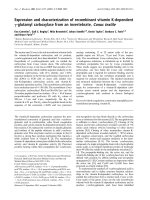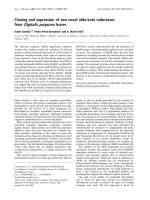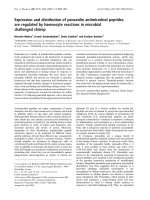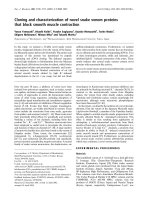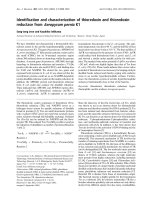Báo cáo y học: "Presentation and management of keloid scarring following median sternotomy: a case study" doc
Bạn đang xem bản rút gọn của tài liệu. Xem và tải ngay bản đầy đủ của tài liệu tại đây (493.3 KB, 4 trang )
CAS E STU D Y Open Access
Presentation and management of keloid scarring
following median sternotomy: a case study
Rikesh Patel, Sotiris C Papaspyros
*
, Kalyana C Javangula, Unnikrishnan Nair
Abstract
Introduction: Keloid scars following median sternotomy are rare and occur more frequently in pigmented skin.
Different management strategies have been described with variable success. We present a case of keloid scar
formation following cardiac surgery including our management and the final aesthetic result.
Case description: A 64 year old female of fair complexion underwent mitral valve replacement. The procedure
and postoperative recovery were uncomplicated, however, during the following year, thick keloid scars formed
over the incision sites. Initial non surgical measures failed to relieve pain and did not offer any tangible aesthetic
benefit. Eventually surgical excision was attempted. She presented to our clinic for nine months follow up with
significant improvement in pain and aesthetic result.
Discussion and Evaluation: Several theories have attempted to explore the pathophysiology of keloid scar
formation. A number of predisposing factors have been documented however none existed in this case. A variety
of invasive and non invasive approaches have been described but significant differences in success rates and
methodology of investigations still precludes a standardized management protocol.
Conclusions: In this case stud y a rare presentation of keloid scar has been presented. The variety of methods used
to improve pain and aesthetic result demonstrates the propensity of keloid scars to recur and the therapeutic
challenges that surgeons have to face in their quest for a satisfactory patient outcome.
Background
Keloid and hypertrophic scars are benign and f ibrotic
proliferations which demonstrate abnormal wound-
healing responses in susceptible individuals [1]. Scar
hypertrophy following mid line sternotomy for cardiac
surgery is rare, occurring more in pigmented skin. It is
estimated that up to 4.5% of the general populati on suf-
fer from hypertrophic scarring [2]. We describe a
patient of fa ir complexion who developed a thick keloid
scar at the sites of sternotomy, chest drains and tempor-
ary pacing wire.
Case presentation
A 64 year old female of Chinese origin underwent
uncomplicated mechanical mitral valve replacement in
2002. She was reviewed six weeks following discharge.
The sternal wound was healing slowly, but there were
no signs of infection.
Past surgical history included sterilisation in 1962,
haemorrhoidectomy in 1983 and hyst erectomy for
fibroids in 1985. None of these operations had resulted
in scar hypertrophy. No other significant medical history
was present.
She made an uncomplicated recovery from her mitral
valve surgery and she was discharged back to her gen-
eral practitioner (GP). In the next 9 months, she noticed
increasing pain and thickness of the sternotomy and
previous chest drain scars. She was initially treated by
her GP with local anti-inflammatory agents with no
noticeable improvement. She searched for other treat-
ment options on the internet and chose to use Cica-
Care
™ (Smith & Nephew™), a silicone gel sheet for six
months with little relief. At that stage her GP referred
her to a plastic surgeon and a pain therapist who treated
her with local steroid and lidocaine injections for
approximately 4 years with no improvement. Eventually
she was seen by her cardiologist w ho referred he r back
to our cardiothoracic unit.
* Correspondence:
Leeds General Infirmary, Great George street, Leeds LS13EX, UK
Patel et al. Journal of Cardiothoracic Surgery 2010, 5:122
/>© 2010 Patel et al ; licensee BioMed Cen tral Ltd. This i s an Open Access article distributed under the terms of the Creative Commons
Attribution License ( which permits unrestricted use, distribution, and reproductio n in
any medium, provided the origina l work is prop erly cited.
Her clinical examination confirmed a 12 cm long
keloid scar at the site of the sternotomy and two other
keloid scars inferiorly at the site of previous chest drains
and pacing wires. (Figure 1)
These were extremely tender on light palpation, parti-
cularlyoverthesiteofthesternalwires.Noneofthe
wires were palpable. Follow ing discussion on treatment
options she agreed to have surgical excision of the scar
and primary closure.
In Nove mber 2008, the patient underwent excision o f the
keloid scar with removal of the sternal wires and recon-
struction of the wound with three layers of suture (1
Dexon
™ Covidien UK ™) under general anaesthetic. M obili-
sation of the subcutaneous tissues was required for approxi-
mation of the skin edges. Skin was closed with P rolen e
™
(Ethicon™). Sutures were removed after ten days and a
pressure dressing was applied. We were not sure if this
patient was allergic to the Monocryl
™ and we therefore
chose to use a removable material such as Prolene
™. The
histology of the keloid scar did not show evidence of
malignancy.
The hypertrophied scar at the pacing wire site was
deliberately left untouche d in order to compare any
future scar formation. (Figure 2) She was discharged
home three days later. (Figure 3)
The patient was reviewed in the outpatients clinic six
weeks later. The wound was healing well w ith minimal
tenderness over the scar sites (Figure 4). Nine months
after excision there was evidence of recurrence of her
scar, however this was of a lesser degree (Figure 5). The
patient felt that pain related to her scar had markedly
improved and was satisfied with the overall result.
Discussion
Several theories exist on the development of hypertro-
phied or keloid scarring. Predisposing factors include
age, sex, race, colour of the skin, anatomic site and
post-operative infection. Atiyeh et al. reported keloid
and hypertrophic scars as two separate processes that
require different therapeutic approaches [3].
The patient in this case report had no apparent pre-
disposition for formation of such pronounced scar
hypertrophy. Her skin was fair, the sternotomy wound
was not infected, and she had no previous history of
scar hypertrophy following surgery.
Elliot et al. studied scar change in presternal areas in
fair-skinned population following median sternotomy
for open heart s urgery [4]. Although they reported no
keloid formation, they did o bserve cases of scar hyper-
trophy and stretching, which was unrelated to the sub-
cuticular suture material used. They noted scar
hypertro phy to occ ur predominantly over the scar over-
lying t he sternal body and particularly in females. Scar
stretching occurred over the lower third of the wound
overlying the xiphisternum and upper abdomen.
Figure 1 Keloid scar 4 years post op. Keloid scarring at site of
previous median sternotomy, chest drains and temporary pacing
wires.
Figure 2 Immediately post surgical excision. Surgical excision of
scar and sternal wires removal was performed with satisfactory
result.
Patel et al. Journal of Cardiothoracic Surgery 2010, 5:122
/>Page 2 of 4
Methods described for treatment of keloid and hype r-
trophic scars include local corticosteroid injection,
pulsed dye lamp treatment, use of silicone gels and exci-
sion of the scar. Currently there is no evidence on
superiority of one particular modality [5-8].
In this case report non-invasive management options
were ini tially pursued (silicone elastomer sheeting) due
to their relative ease of use and low risk of adverse
effects. Although the exact mechanisms of action are
unknown, there have been reports of acceptable results
[9]. Application of a pressure dressing after surgical
excision wa s used on this patient because simple surgi-
cal excision without use of adjuncts is commonly fol-
lowed by recurrence [10].
Mofikyo et al. were unable to identify a single, reliable
and effective protocol regarding management. They
reported that surgical excision with post-operative
Figure 5 9monthspostexcision. Hypertrophy has recurred
however the result is more aesthetically acceptable than the
original keloid scar.
Figure 4 6 weeks post excision.
Figure 3 Day 3 post excision.
Patel et al. Journal of Cardiothoracic Surgery 2010, 5:122
/>Page 3 of 4
topical steroid injection had low recurrence rates [11].
Sternotomy incisions are relatively immobile and skin
closure is free from tension. The u sual suture material
for skin closure in our unit is monofilament polymer
(Monocryl
™).Thereissomeevidencethatitproduces
significantly smaller and less reactive scars than other
suture materials such as Vicryl-rapide [12].
Durkaya et al. found that the lower half of the w ound
was more susceptible to scarring regardless of the suture
material used, but the upper part was more susceptible
to hypertrophy with the use of absorbable sutures [13].
Overall the risk of scar hypertrophy is less with the use
of monofilament sutures when compared with absorb-
able sutures. The relative mobility and increased tension
over the xiphoid process was felt to yield a less satisfac-
tory result.
Conclusion
This case study demonstrates the propensity of keloid
scars to recur despite surgical intervention. However
there was a significant improvement in aesthetic result
and symptoms and this led to patient satisfaction.
Consent
The authors confirm that written consent has been
obtained from patient in order to publish photographs
and relevant clinical information included in the sub-
mitted manuscript.
Authors’ contributions
RP is responsible for acquisition of data and writing the original manuscript.
SP is responsible for conception and design as well as critical revision of the
manuscript, KJ is responsible for conception and design as well as critical
revision of the manuscript, UN is responsible for design and conception and
critical revision of manuscript. All authors approved the final version
submitted.
Competing interests
The authors declare that they have no competing interests.
Received: 15 September 2010 Accepted: 1 December 2010
Published: 1 December 2010
References
1. Köse O, Waseem A: Keloids and Hypertrophic Scars: Are They Two
Different Sides of the Same Coin? Dermatol Surg 2008, 34(3):336-46.
2. Atiyeh BS: Nonsurgical Management of Hypertrophic Scars: Evidence-
Based Therapies, Standard Practices, and Emerging Methods. Aesthetic
Plast Surg 2007, 31(5):468-92.
3. Atiyeh BS, Costagliola M, Hayek SN: Keloid or hypertrophic scar: the
controversy: review of the literature. Ann Plast Surg 2005, 54(6):676-80.
4. Elliot D, Cory-Pearce R, Rees GM: The behaviour of presternal scars in a
fair-skinned population. Ann R Coll Surg Engl 1985, 67(4):238-40.
5. Saray Y, Gulec A: Treatment of keloids and hypertrophic scars with
dermojet injections of bleomycin: A preliminary study. Int J Dermatol
2005, 44(9):777-84.
6. Al-Attar A, Mess S, Thomassen JM, Kauffman CL, Davison SP: Keloid
Pathogenesis and Treatment. Plast Reconstr Surg 2006, 117(1):286-300.
7. Alster TS, West TB: Treatment of scars: a review. Ann Plast Surg 1997,
39(4):418-32.
8. Manuskiatti W, Fitzpatrick RE: Treatment response of keloidal and
hypertrophic sternotomy scars: comparison among intralesional
corticosteroid, 5-fluoracil, and 585 nm flashlamp-pumped pulsed-dye
laser treatments. Arch Dermatol 2002, 138(9):1149-55.
9. Berman B, Perez OA, Konda S, Kohut BE, Viera MH, Delgado S, Zell D, Li Q:
A review of the biologic effects, clinical efficacy, and safety of silicone
elastomer sheeting for hypertrophic and keloid scar treatment and
management. Dermatol Surg 2007, 33(11):1291-302.
10. Alster TS, Tanzi EL: Hypertrophic scars and keloids: etiology and
management. Am J Clin Dermatol 2003, 4(4):235-43.
11. Mofofikyo BO, Adeyemo WL, Abdus-salam AA: Keloid and hypertrophic
scars: a review of recent developments in pathogenesis and
management. Nig Q J Hosp Med 2007, 17(4):134-9.
12. Niessen F, Spauwen P, Kon M: The role of suture material in hypertrophic
scar formation: Monocryl vs. Vicryl-rapide. Ann Plast Surg 1997,
39(3):254-60.
13. Durkaya S, Kaptanoglu M, Nadir A, Yilmaz S, Cinar Z, Dogan K: Do
absorbable sutures exacerbate presternal scarring? Tex Heart Inst J 2005,
32(4):544-8.
doi:10.1186/1749-8090-5-122
Cite this article as: Patel et al.: Presentation and management of keloid
scarring following median sternotomy: a case study. Journal of
Cardiothoracic Surgery 2010 5:122.
Submit your next manuscript to BioMed Central
and take full advantage of:
• Convenient online submission
• Thorough peer review
• No space constraints or color figure charges
• Immediate publication on acceptance
• Inclusion in PubMed, CAS, Scopus and Google Scholar
• Research which is freely available for redistribution
Submit your manuscript at
www.biomedcentral.com/submit
Patel et al. Journal of Cardiothoracic Surgery 2010, 5:122
/>Page 4 of 4





